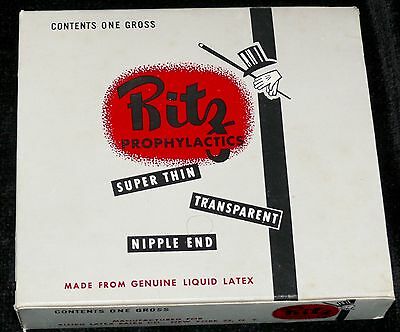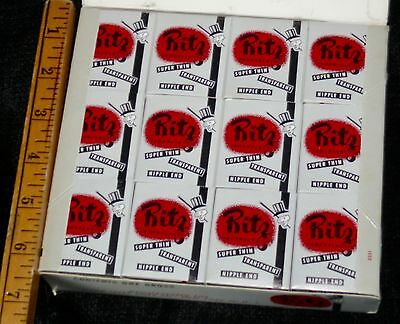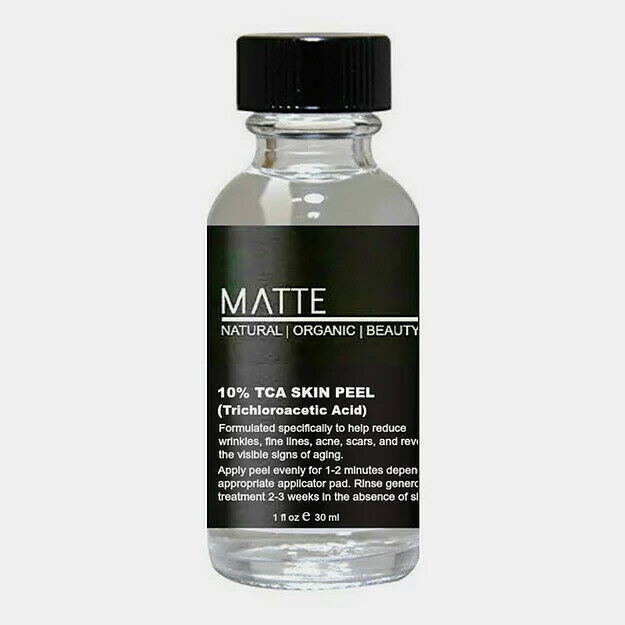-40%
VINTAGE CONDOMS RITZ PROPHYLACTICS MINT IN STORE BOX 144 PACKAGES
$ 216.48
- Description
- Size Guide
Description
UNOPENED MINT IN BOX ONE GROSS CONDOMS (144) SEALED IN INDIVIDUAL PACKAGINGHistory of condoms
From Wikipedia, the free encyclopedia
The examples and perspective in this article
deal primarily with Western culture and do not represent a
worldwide view
of the subject
.
Please
improve this article
and discuss the issue on the
talk page
.
(April 2011)
The
history of condoms
goes back at least several centuries, and perhaps beyond. For most of their history,
condoms
have been used both as a method of
birth control
, and as a protective measure against
sexually transmitted diseases
. Condoms have been made from a variety of materials; prior to the 19th century, chemically treated linen and animal tissue (intestine or bladder) are the best documented varieties. Rubber condoms gained popularity in the mid-19th century, and in the early 20th century major advances were made in manufacturing techniques. Prior to the introduction of the
combined oral contraceptive pill
, condoms were the most popular birth control method in the Western world. In the second half of the 20th century, the low cost of condoms contributed to their importance in
family planning
programs throughout the developing world. Condoms have also become increasingly important in efforts to fight the
AIDS pandemic
. The oldest condoms ever excavated were found in a cesspit located in the grounds of
Dudley Castle
and were made from animal membrane, the condoms dated back to as early as 1642.
[1]
Contents
[
hide
]
1
Antiquity to the Middle Ages
2
1500s to the 1800s
2.1
Renaissance
2.2
18th century
2.3
Expanded marketing and introduction of rubber
2.4
Increased popularity despite legal impediments
3
1900 to present
3.1
World War I to the 1920s
3.2
Invention of latex and manufacturing automation
3.3
Great Depression
3.4
World War II to 1980
3.5
After the discovery of AIDS
4
Etymology and other terms
5
Major manufacturers
6
Innovation
7
References
Antiquity to the Middle Ages
[
edit
]
Whether condoms were used in ancient civilizations is debated by archaeologists and historians.
[2]
:11
The oldest claimed representation of condom use is a painting in the French cave
Grotte des Combarelles
;
[2]
:11
the paintings in this cave are 12,000–15,000 years old.
[3]
Societies in the ancient civilizations of Egypt, Greece, and Rome preferred small families and are known to have practiced a variety of birth control methods.
[2]
:12,16–17,22
However, these societies viewed
birth control
as a woman's responsibility, and the only well-documented contraception methods were female-controlled devices (both possibly effective, such as
pessaries
, and ineffective, such as
amulets
).
[2]
:17,23
The writings of these societies contain "veiled references" to male-controlled contraceptive methods that might have been condoms, but most historians interpret them as referring to
coitus interruptus
or
anal sex
.
[2]
:21,24
The
loincloths
worn by Egyptian and Greek laborers were very spare, sometimes consisting of little more than a covering for the glans of the penis. Records of these types of loincloths being worn by men in higher classes have made some historians speculate they were worn during intercourse;
[2]
:13–15,18–20
others, however, are doubtful of such interpretations.
[4]
Historians may also cite one legend of
Minos
, related by
Antoninus Liberalis
in 150 AD, as suggestive of condom use in ancient societies. This legend describes a curse that caused Minos' semen to contain serpents and scorpions. To protect his sexual partner from these animals, Minos used a goat's bladder as a female condom.
[2]
:18
[4]
Contraceptives fell out of use in Europe after the
decline of the Roman Empire
in the 5th century; the use of contraceptive pessaries, for example, is not documented again until the 15th century. If condoms were used during the Roman Empire, knowledge of them may have been lost during its decline.
[2]
:33,42
In the writings of Muslims and Jews during the Middle Ages, there are some references to attempts at male-controlled contraception, including suggestions to cover the penis in tar or soak it in onion juice. Some of these writings might describe condom use, but they are "oblique", "veiled", and "vague".
[2]
:38–41
1500s to the 1800s
[
edit
]
Renaissance
[
edit
]
A page from
De Morbo Gallico
(The French Disease), Gabriele Falloppio's treatise on syphilis. Published in 1564, it describes what is possibly the first use of condoms.
Prior to the 15th century, some use of glans condoms (devices covering only the head of the penis) is recorded in Asia. Glans condoms seem to have been used for birth control, and to have been known only by members of the upper classes. In China, glans condoms may have been made of oiled silk paper, or of
lamb intestines
. In Japan, they were made of tortoise shell or animal horn.
[2]
:60–1
The first well-documented outbreak of what is now known as
syphilis
occurred in 1494 among French troops.
[5]
The disease then swept across Europe. As
Jared Diamond
describes it, "when syphilis was first definitely recorded in Europe in 1495, its
pustules
often covered the body from the head to the knees, caused flesh to fall from people's faces, and led to death within a few months." (The disease is less frequently fatal today.
[6]
) By 1505, the disease had spread to Asia, and within a few decades had "decimated large areas of China".
[2]
:50,60
In 16th century Italy,
Gabriele Falloppio
authored the earliest uncontested description of condom use.
De Morbo Gallico
("The French Disease", referring to syphilis) was published in 1564, two years after Fallopio's death. In this tract, he recommended use of a device he claimed to have invented: linen sheaths soaked in a chemical solution and allowed to dry before use. The cloths he described were sized to cover the
glans
of the penis, and were held on with a ribbon.
[2]
:51,54–5
[7]
Fallopio claimed to have performed an experimental trial of the linen sheath on 1100 men, and reported that none of them had contracted the dreaded disease.
[4]
After the publication of
De Morbo Gallico
, use of penis coverings to protect from disease is described in a wide variety of literature throughout Europe. The first indication these devices were used for birth control, rather than disease prevention, is the 1605 theological publication
De iustitia et iure
(On justice and law) by Catholic theologian
Leonardus Lessius
: he condemned them as immoral.
[2]
:56
The first explicit description that
un petit linge
(a small cloth) was used to prevent pregnancy is from 1655: a French novel and play titled
L'Escole des Filles
(The Philosophy of Girls). In 1666, the English Birth Rate Commission attributed a recent downward fertility rate to use of "condons", the first documented use of that word (or any similar spelling).
[2]
:66–8
In addition to linen, condoms during the
Renaissance
were made out of intestines and bladder. Cleaned and prepared intestine for use in glove making had been sold commercially since at least the 13th century.
[2]
:44–5
Condoms made from bladder and dating to the 1640s were discovered in an English privy; it is believed they were used by soldiers of
King Charles I
.
[2]
:68–9
Dutch traders introduced condoms made from "fine leather" to Japan. Unlike the horn condoms used previously, these leather condoms covered the entire penis.
[2]
:61
18th century
[
edit
]
Written references to condom use became much more common during the 18th century. Not all of the attention was positive: in 1708,
John Campbell
unsuccessfully asked Parliament to make the devices illegal.
[2]
:73
Noted English physician Daniel Turner condemned the condom, publishing his arguments against their use in 1717. He disliked condoms because they did not offer full protection against syphilis. He also seems to have argued that belief in the protection condoms offered encouraged men to engage in sex with unsafe partners - but then, because of the loss of sensation caused by condoms, these same men often neglected to actually use the devices. The French medical professor
Jean Astruc
wrote his own anti-condom treatise in 1736, citing Turner as the authority in this area. Physicians later in the 18th century also spoke against the condom, but not on medical grounds: rather, they expressed the belief that contraception was immoral.
[2]
:86–8,92
The condom market grew rapidly, however. 18th century condoms were available in a variety of qualities and sizes, made from either linen treated with chemicals, or "skin" (bladder or intestine softened by treatment with
sulphur
and
lye
).
[2]
:94–5
They were sold at pubs, barbershops, chemist shops, open-air markets, and at the theater throughout Europe and Russia.
[2]
:90–2,97,104
The first recorded inspection of condom quality is found in the
memoirs of Giacomo Casanova
(which cover his life until 1774): to test for holes, he would often blow them up before use.
[2]
:108
[4]
A condom made from animal intestine circa 1900.
Couples in colonial America relied on female-controlled methods of contraception, if they used contraceptives at all. The first known documents describing American condom use were written around 1800, two to three decades after the
American Revolutionary War
.
[2]
:116–7
Also around 1800, linen condoms lost popularity in the market and their production ceased: they were more expensive and were viewed as less comfortable when compared to skin condoms.
[2]
:94–5
Up to the 19th century, condoms were generally used only by the middle and upper classes. One reason for the lack of condom use was that the working classes tended to lack education on the dangers of sexually transmitted infections. Perhaps more importantly, condoms were unaffordable for many: for a typical prostitute, a single condom might cost several months' pay.
[2]
:119–21
Expanded marketing and introduction of rubber
[
edit
]
The early 19th century saw contraceptives promoted to the poorer classes for the first time: birth control advocates in England included
Jeremy Bentham
and
Richard Carlile
, and noted American advocates included
Robert Dale Owen
and
Charles Knowlton
. Writers on contraception tended to prefer other methods of birth control, citing both the expense of condoms and their unreliability (they were often riddled with holes, and often fell off or broke), but they discussed condoms as a good option for some, and as the only contraceptive that also protected from disease.
[2]
:88,90,125,129–30
One group of British contraceptive advocates distributed condom literature in poor neighborhoods, with instructions on how to make the devices at home; in the 1840s, similar tracts were distributed in both cities and rural areas through the United States.
[2]
:126,136
From the 1820s through the 1870s, popular women and men lecturers traveled around America teaching about physiology and sexual matters. Many of them sold birth control devices, including condoms, after their lectures. They were condemned by many moralists and medical professionals, including America's first female doctor
Elizabeth Blackwell
. Blackwell accused the lecturers of spreading doctrines of "abortion and prostitution".
[2]
:130–2
In the 1840s, advertisements for condoms began to appear in British newspapers, and in 1861 a condom advertisement appeared in the
New York Times
.
[2]
:127,138
The
rubber vulcanization
process was invented by
Charles Goodyear
in 1839, and patented in 1844.
[8]
The first rubber condom was produced in 1855,
[9]
and by the late 1850s several major rubber companies were mass-producing, among other items, rubber condoms. A main advantage of rubber condoms was their reusability, making them a more economical choice in the long term. Compared to the 19th century rubber condoms, however, skin condoms were initially cheaper and offered better sensitivity. For these reasons, skin condoms remained more popular than the rubber variety. However, by the end of the 19th century "rubber" had become a euphemism for condoms in countries around the world.
[2]
:134–5,157,219
For many decades, rubber condoms were manufactured by wrapping strips of raw rubber around penis-shaped molds, then dipping the wrapped molds in a chemical solution to cure the rubber.
[2]
:148
The earliest rubber condoms covered only the glans of the penis; a doctor had to measure each man and order the correct size. Even with the medical fittings, however, glans condoms tended to fall off during use. Rubber manufacturers quickly discovered they could sell more devices by manufacturing full-length one-size-fits-all condoms to be sold in pharmacies.
[2]
:135
Increased popularity despite legal impediments
[
edit
]
Distribution of condoms in the United States was limited by passage of the
Comstock laws
, which included a federal act banning the mailing of contraceptive information (passed in 1873) as well as State laws that banned the manufacture and sale of condoms in thirty states.
[2]
:144,193
In
Ireland
the 1889 Indecent Advertisements Act made it illegal to advertise condoms, although their manufacture and sale remained legal.
[2]
:163–4,168
Contraceptives were illegal in 19th century Italy and Germany, but condoms were allowed for disease prevention.
[2]
:169–70
Despite legal obstacles, condoms continued to be readily available in both Europe and America, widely advertised under euphemisms such as
male shield
and
rubber good
.
[2]
:146–7
In late 19th century England, condoms were known as "a little something for the weekend".
[2]
:165
Only in the
Republic of Ireland
were condoms effectively outlawed. There, their sale and manufacture remained illegal until the 1970s.
[2]
:171
Opposition to condoms did not only come from moralists: by the late 19th century the feminist movement in both Europe and America was decidedly anti-condom. Feminists wanted birth control to be exclusively in the hands of women, and disapproved of male-controlled methods such as the condom.
[2]
:129,152–3
Despite social and legal opposition, at the end of the 19th century the condom was the Western world's most popular birth control method. Two surveys conducted in New York in 1890 and 1900 found that 45% of the women surveyed were using condoms to prevent pregnancy.
[2]
:173–4
A survey in Boston just prior to
World War I
concluded that three million condoms were sold in that city every year.
[2]
:192–3
1870s England saw the founding of the first major condom manufacturing company, E. Lambert and Son of Dalston.
[2]
:165
In 1882, German immigrant
Julius Schmidt
founded one of the largest and longest-lasting condom businesses, Julius Schmid, Inc. (he dropped the 't' from his name in an effort to appear less Jewish). This New York business initially manufactured only skin condoms (in 1890 he was arrested by
Anthony Comstock
for having almost seven hundred of the devices in his house).
[2]
:154–6
In 1912, a German named
Julius Fromm
developed a new, improved manufacturing technique for condoms: dipping glass molds into a raw rubber solution.
[9]
Called
cement dipping
, this method required adding gasoline or benzene to the rubber to make it liquid.
[2]
:200
In America, Schmid was the first company to use the new technique. Using the new dipping method, French condom manufacturers were the first to add textures to condoms.
[2]
:169–70
Fromm was the first company to sell a branded line of condoms, Fromm's Act, which remains popular Germany today.
[9]
The condom lines manufactured by Schmid, Shieks and Ramses, were sold through the late 1990s.
[2]
:154–6
Youngs Rubber Company, founded by Merle Youngs in late 19th century America, introduced Trojans.
[2]
:191
Beginning in the second half of the 19th century, American rates of sexually transmitted diseases skyrocketed. Causes cited by historians include effects of the
American Civil War
, and the ignorance of prevention methods promoted by the Comstock laws.
[2]
:137–8,159
To fight the growing epidemic, sexual education classes were introduced to public schools for the first time, teaching about venereal diseases and how they were transmitted. They generally taught that abstinence was the only way to avoid sexually transmitted diseases.
[2]
:179–80
Condoms were not promoted for disease prevention; the medical community and moral watchdogs considered STDs to be punishment for sexual misbehavior. The stigma on victims of these diseases was so great that many hospitals refused to treat people who had syphilis.
[2]
:176
1900 to present
[
edit
]
World War I to the 1920s
[
edit
]
A World War I-era U.S. military poster promoting abstinence.
The German military was the first to promote condom use among its soldiers, beginning in the second half of the 19th century.
[2]
:169,181
Early 20th century experiments by the American military concluded that providing condoms to soldiers significantly lowered rates of sexually transmitted diseases.
[2]
:180–3
During
World War I
, the United States and (at the beginning of the war only) Britain were the only countries with soldiers in Europe who did not provide condoms and promote their use.
[2]
:187–90
By the end of the war, the American military had diagnosed almost 400,000 cases of syphilis and
gonorrhea
, a historic high.
[2]
:191
From just before 1900 to the beginning of World War I, almost all condoms used in Europe were imported from Germany. Germany not only exported condoms to other European countries, but was a major supplier to Australia, New Zealand, and Canada. During the war, the American companies Schmid and Youngs became the main suppliers of condoms to the European
Allies
.
[2]
:156,170,191
By the early 1920s, however, most of Europe's condoms were once again made in Germany.
[2]
:199
In 1918, just before the end of the war, an American court overturned a conviction against
Margaret Sanger
. In this case, the judge ruled that condoms could be legally advertised and sold for the prevention of disease.
[10]
There were still a few state laws against buying and selling contraceptives, and advertising condoms as birth control devices remained illegal in over thirty states.
[2]
:266
But condoms began to be publicly, legally sold to Americans for the first time in forty-five years.
[2]
:192–3
Through the 1920s, catchy names and slick packaging became an increasingly important marketing technique for many consumer items, including condoms and cigarettes.
[2]
:197
Quality testing became more common, involving filling each condom with air followed by one of several methods intended to detect loss of pressure. Several American companies sold their rejects under cheaper brand names rather than discarding them.
[2]
:204,206,221–2
Consumers were advised to perform similar tests themselves before use, although few actually did so.
[2]
:223
Worldwide, condoms sales doubled in the 1920s.
[2]
:210
Still, there were many prominent opponents of condoms. Founder of psychoanalysis
Sigmund Freud
opposed all methods of birth control on the grounds that their failure rates were too high. Freud was especially opposed to the condom because it cut down on sexual pleasure. Some feminists continued to oppose male-controlled contraceptives such as condoms. Many moralists and medical professionals opposed all methods of contraception. In 1920 the Church of England's
Lambeth Conference
condemned all "unnatural means of conception avoidance." London's Bishop
Arthur Winnington-Ingram
complained of the
huge
number of condoms discarded in alleyways and parks, especially after weekends and holidays.
[2]
:211–2
In the U.S., condom advertising was legally restricted to their use as disease preventatives. They could be openly marketed as birth control devices in Britain, but purchasing condoms in Britain was socially awkward compared to the U.S. They were generally requested with the euphemism "a little something for the weekend."
Boots
, the largest pharmacy chain in Britain, stopped selling condoms altogether in the 1920s, a policy that was not reversed until the 1960s.
[2]
:208–10
In post-World War I France, the government was concerned about falling birth rates. In response, it outlawed all contraceptives, including condoms. Contraception was also illegal in Spain. European militaries continued to provide condoms to their members for disease protection, even in countries where they were illegal for the general population.
[2]
:213–4
Invention of latex and manufacturing automation
[
edit
]
Latex
, rubber suspended in water, was invented in 1920. Youngs Rubber Company was the first to manufacture a latex condom, an improved version of their Trojan brand. Latex condoms required less labor to produce than cement-dipped rubber condoms, which had to be smoothed by rubbing and trimming. Because it used water to suspend the rubber instead of gasoline and benzene, it eliminated the fire hazard previously associated with all condom factories. Latex condoms also performed better for the consumer: they were stronger and thinner than rubber condoms, and had a shelf life of five years (compared to three months for rubber). Europe's first latex condom was an export from Youngs Rubber Company in 1929. In 1932 the London Rubber Company, which had previously served as a wholesaler for German-manufactured condoms, became Europe's first manufacturer of latex condoms, the Durex.
[2]
:199–200
Until the twenties, all condoms were individually hand-dipped by semiskilled workers. Throughout the decade of the 1920s, advances in automation of condom assembly line were made. Fred Killian patented the first fully automated line in 1930 and installed it in his manufacturing plant in Akron, Ohio. Killian charged ,000 for his conveyor system - as much as million in today's dollars. Automated lines dramatically lowered the price of condoms. Major condom manufacturers bought or leased conveyor systems, and small manufacturers were driven out of business.
[2]
:201–3
The skin condom, now significantly more expensive than the latex variety, became restricted to a niche high-end market.
[2]
:220

















